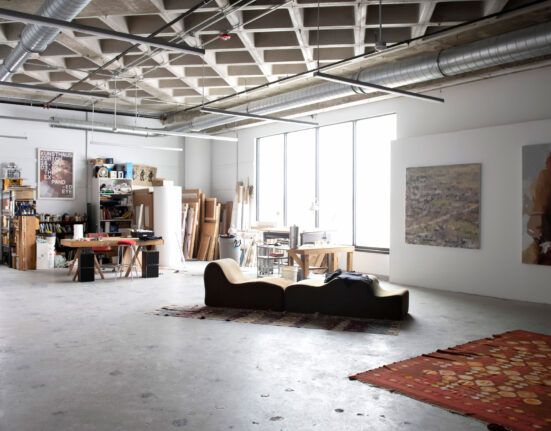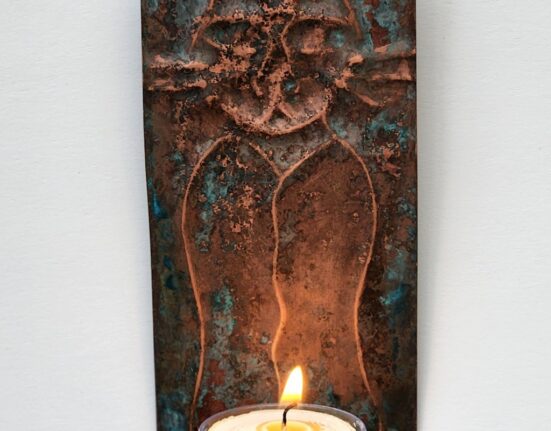“History’s a b—-,” says Tamara, played by Eden Espinosa in the new musical “Lempicka.” “But so am I.”
The creators of “Lempicka” — book, lyrics and concept by Carson Kreitzer, music by Matt Gould — want their title character to be many things: feminist, sexual revolutionary, trailblazing entrepreneur, tortured artist, victim and survivor, and martyr to the passing fads of art and history. There’s enough evidence in the life of the real Lempicka to justify most of those claims to some degree, but this musical wants to prove all of them, absolutely, in the space of two and a half hours. The result is a breathless, up-tempo force march through some of the darkest decades in European history, and a big, messy, fascinating life is processed into a theater piece that is just big and messy.
The musical, first seen at the Williamstown Theatre Festival in 2018, is framed as flashback: an old and embittered artist alone on a park bench in Los Angeles in 1975, ruminating on her life and career, wondering, “How did I wind up here?” Her work is forgotten and out-of-fashion, and she is exiled in a world far from the wit and sophistication with which she once surrounded herself.
Suddenly it’s 1916, she is young again, about to be married, and her mother implores her to give up painting and live a proper, respectable life. Revolution intervenes and we’re off, on a highway built by “Hamilton,” careening to the first of the major traumas. After she fails to win her husband Tadeusz’s freedom by offering her jewelry to the menacing Bolsheviks, she is forced to yield her body.
The young couple flee west, their flight traced on a map above the stage (scenic design by Riccardo Hernández), which will also bear fragments of the luminous, sensual, slightly chilly art deco paintings of the real Lempicka, whose work has been collected and promoted by Madonna. An appealing ensemble of dancers (choreography by Raja Feather Kelly), by turns androgynous, louche, menacing and camp, set the tone for a frenetic idyll of ambition, success and debauchery during the interwar years in Paris.
Lempicka’s art is represented onstage mainly with empty easels and vacant picture frames, and history gets the same treatment: present as shadow, not substance. The revolution that disrupts the lives of our main characters is cruel, but the actual grievance that sparks it is passed over lightly. Decades of want, misery and political violence scroll by, seen in black-and-white film clips. If you want to learn more about that, and how it intersected with art, go see the Museum of Modern Art’s Käthe Kollwitz show, an artist a generation older than Lempicka, who left a far greater legacy.
In “Lempicka,” history is, as they say, just one dance number after another. It summons the shocks and jolts that forge the identity and resiliency of the artist, which doesn’t yield an actual character, but more of a ready-made hero for contemporary political tastes. Espinosa does heroic work tying the threads together, but instead of inhabiting a character with multiple facets, she’s left to reconcile multiple characters serving various theatrical purposes.
Lempicka has an affair with Rafaela, a self-reliant prostitute (magnificently played and sung by Amber Iman), and her work — portraits of confident women and statuesque nudes — is celebrated as liberating by the LGBT habitués of the Monocle nightclub, which feels a lot like the Kit Kat Club of “Cabaret.”
She also wrests significant independence from Tadeusz, played with starchy elegance by Andrew Samonsky, but when she tells him a terrible secret, the scene falls flat because their relationship has never been coherent. She goes her own way, resisting the grim, modernist ideology of the futurist prophet, Marinetti, depicted as an obnoxious drunkard and brutal social seer by George Abud. But it’s unclear if we should admire the artist for her independence, or her pragmatic, even cynical submission to elite taste. The show seems to credit her not just with embodying the New Woman ideal of the 1920s, but with inventing it. “Your women,” says a ghostly apparition of Rafaela, “they’re taking over the world.”
Director Rachel Chavkin’s production is stylish and fast-paced, and opens up just enough room for a few genuine theatrical moments. Iman’s “The Most Beautiful Bracelet” is an Act I showstopper, as is the highlight of the evening, Beth Leavel’s tender, determined yet resigned song about love and memory in Act II in which she plays an aristocratic woman facing up to her own death.
Gould’s music lacks a strong melodic profile, and tends to move quickly to the big, fortissimo notes that flatter his singer’s voices. But the text setting is clear and effective and the music seems to disappear when the drama — Leavel’s heartbreaking acknowledgment of mortality — is the essential thing.
The real Lempicka is having a moment right now. Her work is on view at an exhibition at Sotheby’s, and will be given museum treatment later this year at a retrospective in San Francisco. She is not as well known as she deserves to be, but she was not quite as forgotten and forlorn as this musical claims she was. Her career sputtered after she emigrated to the United States and later Mexico. But it was already being rediscovered in the 1960s, subject of a major retrospective in Paris in 1972, and has been cropping up in Madonna’s videos and spectacles for decades.
In a review, published in the late 1980s in the Woman’s Art Journal, a slightly dyspeptic critic argued Lempicka’s art was more rejected than forgotten: “Her Art Deco portraiture is largely unknown today for two good reasons: it is hopelessly out of date, and none of it was very good to begin with.”
“Lempicka” challenges both those assumptions. Audiences may be inspired by the show to seek out the art itself, which offers a more measured and reasonable riposte.
Lempicka, at Longacre Theatre, 220 W. 48th St., in New York. 150 minutes, including intermission. lempickamusical.com.







